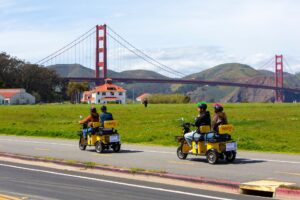Exploring the History and Beauty of Crissy Field in San Francisco
Crissy Field, located on the northern shore of the San Francisco Peninsula, has a rich history and offers visitors a stunning natural experience. From its origins as a tidal wetland used by the Ohlone people to its transformation into a bustling airfield during World War I, and finally, its restoration into a breathtaking urban national park, Crissy Field has undergone remarkable changes. In this article, we’ll delve into the fascinating history and current attractions of Crissy Field, including fun facts and must-visit places.
A Glimpse into Crissy Field’s Past
Ohlone People and Early Settlement
- Crissy Field’s history dates back to its use as a seasonal resource by the Ohlone people, who harvested shellfish and fish in the area.
- Spanish settlers arrived in 1776, using the land for livestock grazing and agriculture.
- The marsh site, covering 127 acres, was filled in during the 1870s.
Military Presence Takes Over
- In 1915, the site saw a significant change when it was used for the Panama Pacific International Exposition.
- The U.S. Army took control in 1846, using the area for dumping and draining.
- An aerodrome was constructed on the filled marshlands in the early 1920s.
Crissy Field’s Contribution to Aviation
- Crissy Field played a central role in early 20th-century military aviation.
- Pilots conducted maneuvers, mock battles, endurance flights, and surveyed the western United States by air.
- The airfield was named in honor of Major Dana H. Crissy, who died in a plane crash in 1919 during a transcontinental reliability and endurance test.
Challenges and Closure
- Despite its ideal location, wind, fog, and the construction of the Golden Gate Bridge posed challenges for flying from Crissy Field.
- Hamilton Field in Marin County opened in 1936, reducing Crissy Field’s role as a primary air base.
- During World War II, the site served as a training ground and later as an assembly area for troop mobilization.
Transition to a National Park
- In 1994, the Army decommissioned the Presidio, leaving Crissy Field in the hands of the National Park Service.
- Environmental concerns led to a comprehensive restoration effort, with the Crissy Field Center opening to the public in 2001.
The Restoration of Crissy Field
Collaborative Effort
- San Francisco landscape architecture firm Hargreaves Associates oversaw the restoration.
- Thousands of volunteers contributed to the project, planting over 100,000 native plants.
- The project received significant funding from foundations and public donations.
Environmental Restoration
- The restoration aimed to recreate the marsh to its pre-military condition.
- Hazardous materials were removed, and the tidal wetlands were redesigned to simulate their natural state.
- Crissy Field now provides stunning views of the San Francisco Bay area, Alcatraz, and the Golden Gate Bridge.
Present-Day Crissy Field
A Thriving Urban National Park
- Crissy Field is now part of an urban national park, attracting both locals and tourists.
- It offers a mix of natural beauty and historical significance, making it a must-visit destination.
Must-See Features and Attractions
- West Bluff: This area includes a picnic area, the Warming Hut cafe, and trails to the Golden Gate Bridge and Fort Point.
- Beach and Dunes: The shoreline has been restored, providing habitat for native species.
- Promenade and Trails: Explore the Golden Gate Promenade and the San Francisco Bay Trail, offering stunning coastal views.
- Tidal Wetlands: The restored marsh hosts a diverse range of fish and bird species.
- Crissy Field Center: An environmental education center offering programs for youth.
- Cross Country Course: Home to the USF Men’s and Women’s cross country teams.
- Warming Hut Park Store: Shop for books, souvenirs, drinks, and snacks, with proceeds supporting the park.
Fun and Interesting Facts About Crissy Field
- Crissy Field was originally a tidal wetland used by the Ohlone people for harvesting shellfish and fish.
- It was filled in during the 1870s, leading to its use for various purposes over the years.
- The airfield was named after Major Dana H. Crissy, who tragically died during a transcontinental flight test.
- Crissy Field played a vital role in early 20th-century military aviation, including aerial forest fire patrols.
- It witnessed the first successful dawn-to-dusk transcontinental flight across the United States in 1924.
- The Army’s first aerial circumnavigation of the world stopped at Crissy Field in the same year.
- Crissy Field’s location on the water’s edge of the San Francisco Bay made it vulnerable to potential enemy ship attacks during World War II.
- After the air corps left, the site served as a training ground for soldiers during World War II.
- Crissy Field became an urban national park in 1994 under the National Park Service.
- The restoration project at Crissy Field involved the removal of hazardous materials and the recreation of tidal wetlands to their natural state.
- The Haas Foundations and public donations played a significant role in funding the restoration.
- Crissy Field offers breathtaking views of the San Francisco Bay area, Alcatraz, and the iconic Golden Gate Bridge.
Crissy Field’s transformation from a tidal wetland to a bustling airfield and its eventual restoration into a natural urban park is a testament to its rich history and the dedication of those who worked to preserve its beauty. Whether you’re interested in history, nature, or simply enjoying stunning vistas, Crissy Field has something to offer every visitor. So, don’t miss the chance to explore this remarkable destination on your next visit to San Francisco.
Information provided by the National Park Service







